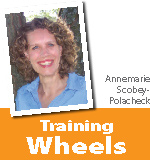 When our children were small, we owned many baby-toting devices. We have a great photo of Bill using the garden hose on the lawn while wearing 2-month-old Liam in a baby sling.
When our children were small, we owned many baby-toting devices. We have a great photo of Bill using the garden hose on the lawn while wearing 2-month-old Liam in a baby sling.
From the sling, we moved on to a front pack. The front pack seemed to lull the babies to sleep, and I would often peel the baby off my front and put him directly in the crib, pack still on, for a nap. They looked like tiny parachuters who had landed safely on their backs.
Related articleCommunication key to healthy parent, adult child relationships |
For our toddlers, we used a mainframe backpack similar to what mountain hikers would wear. I would often vacuum with Jamie in a backpack because if I didn’t strap her on while I was vacuuming, the risk was that she would run off to another room and begin eating small things off the floor. We are still missing tiny Legos from that period of time.
She also had a propensity to throw random objects into the toilet, when either she or the toilet was left unguarded. The backpack kept her safe and had the added benefit of giving me strong shoulders for 18 months. I’m very pleased with a couple photos of myself wearing a tank top during the summer of 2005 thanks to my daily routine of walking around with 24-pound Jamie on my back.
All of these baby-carrying devices served to keep my children and me emotionally close through their early childhood years, even as they left the devices behind and entered kindergarten and the primary grades. By the time they turned 5 or 6, our children probably had no memory of being tucked in a front pack while I did dishes, or being strapped into a backpack on a camping trip. But I believe somewhere in their minds and hearts, they understood they were attached to Bill and me; they had a foundation of protection and closeness; they knew security.
In the early elementary years, the physical closeness of carrying a child morphed to lighter physical contact – holding hands crossing the street; helping to tie shoes; giving a piggy back ride; sitting on a lap while reading.
As the children grew even older, these fell away, too, and closeness moved to doing things together –making brownies; playing Horse in the driveway; riding in the car together to practices and games. The language of closeness changed from touch to time together and conversation.
Just as our attachment to our babies established connection for the next phase of childhood, so, too, our relationship with our adolescent children will determine how close they feel to Bill and me during their young adult years.
This is way trickier than strapping a kid to my back and going about my day. It’s more complex than holding hands and reading together and playing basketball in the driveway.
My friend Emma, mother of a 12-year-old girl and two younger children, says this about parenting a pre-teen: “I think it’s the same as every other relationship; listening is key. I am trying so hard to see my kids for who they are, not who I want them to be.”
Another friend, Heather, who has two children in college and three in grade school, said communicating with her older two children during adolescence has taught her important lessons for parenting her younger ones as they move toward the teen years.
“I have learned to stay present and wait,” she said. “The mistake I often made with the older two is that I approached my conversations with them like I approached an issue at work – let’s strategize, problem-solve, analyze and then recap. What they often want, though, is just a sounding board to try out their own theories or approaches. They need to hear it out loud, to have it roll around, and to have me ask some clarifying questions. In the past, I sometimes ‘hijacked’ their process by jumping in with solutions and theories.”
I can identify with Heather. During the baby years, being a good parent meant living those portions of my kids’ lives that they couldn’t manage yet. I wiped their bottoms; I mashed their bananas; I dressed them.
Slowly, being a good parent changed from doing things for my children to helping them do things themselves – a boost to climb a tree; a spelling hint. But now, they don’t need answers or help quite as much; what they need is that I give them my support as they figure something out on their own.
It’s difficult to hold back from jumping in with all the answers – and this isn’t new – I probably mashed the bananas a month or two longer than I needed to. The paradox of closeness as my children get older is that I am called to build connection by stepping back (without looking away).
The power of parenting well in this stage will be in whether I will be able to hold my gaze on them, nodding encouragement and being available, without rushing in to take over. What my children need from me now is profoundly different than what they needed from me as infants or even as younger children. They need to know that the same love that propelled me to carry them, now requires that I walk beside them.
They need to know that all the energy I put into teaching them the right way to go, I now need to put into seeking to understand them, as they make their own way.
(Annemarie Scobey-Polacheck’s writing on faith and family life has won local and national awards. To see past columns, go to www.discoveringmotherhood.com.)
